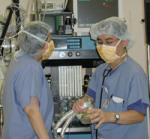by
Michael Johns, Project Manager | August 09, 2006

Anesthesiology Clinical
Experience at Baylor
Affilliated with 5 medical centers, Baylor's Anesthesiology Clinical training is a good choice.
Clinical Experience
The Department of Anesthesiology residency program conforms to the requirements of the American Board of Anesthesiology (ABA). Medical student applicants are accepted through the National Residency Matching Program (NRMP) both at the Clinical Base Year and at the first year of the Clinical Anesthesia continuum. All applications and required documentation must be submitted via the Electronic Residency Application Service (ERAS), which is a part of the Association of American Medical Colleges. Occasionally, positions in the three-year continuum of anesthesia training are available outside the match to applicants with a medical degree and one year of postgraduate training.



Ad Statistics
Times Displayed: 78526
Times Visited: 2794 Ampronix, a Top Master Distributor for Sony Medical, provides Sales, Service & Exchanges for Sony Surgical Displays, Printers, & More. Rely on Us for Expert Support Tailored to Your Needs. Email info@ampronix.com or Call 949-273-8000 for Premier Pricing.
Clinical Experience
The Department of Anesthesiology residency program conforms to the requirements of the American Board of Anesthesiology (ABA). Medical student applicants are accepted through the National Residency Matching Program (NRMP) both at the Clinical Base Year and at the first year of the Clinical Anesthesia continuum. All applications and required documentation must be submitted via the Electronic Residency Application Service (ERAS), which is a part of the Association of American Medical Colleges. Occasionally, positions in the three-year continuum of anesthesia training are available outside the match to applicants with a medical degree and one year of postgraduate training.
The Clinical Base Year
Twelve months of non-anesthesia training are required for entry into the ABA examination system. Anesthesia residents entering at the PGY-1 level via the NRMP receive clinical base year training at affiliated hospitals of Baylor College of Medicine. The clinical base year is designed to expose residents to a variety of inpatient and outpatient clinical settings which provide a foundation upon which anesthesiology training can be built. Residents rotate through the departments of Medicine (Inpatient, Geriatrics, ER, ICU, Cardiology and Pulmonary), Pediatrics (Inpatient), Pathology (Transfusion and Blood Bank) and ENT (Outpatient).
The Clinical Anesthesia Continuum
Residents rotate through all of the participating hospital services during the clinical anesthesia training period. During the first 12 months of clinical anesthesia training, residents focus on learning the fundamentals of anesthetic management of patients undergoing elective and emergent general, ophthalmologic, plastic, oral, orthopedic, gynecologic, obstetric, and urologic surgery. During the next 12 months of training, residents learn to manage increasingly complex patients undergoing pediatric, cardiothoracic, and neurosurgical procedures, and obtain extensive experience in pain management, critical care, and regional anesthetic techniques. During the final 12 months of anesthesia training, residents tailor the clinical experience to meet individual interests while meeting the challenge of managing patients in a variety of clinical settings.
All residents perform pre-anesthetic evaluations and post-anesthetic rounds in direct consultation with the faculty. Residents are given graduated responsibility for the independent provision of anesthetic care based upon progress in the training program. Faculty members are continuously available for consultation and supervision.
Click here for more information about
Baylor's Anesthesiology Clinical Experience

